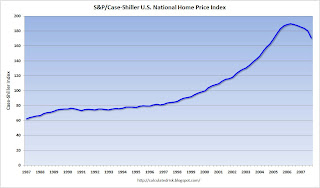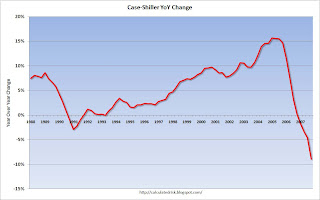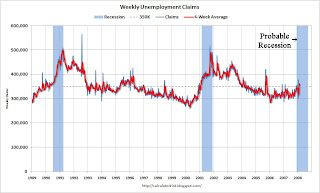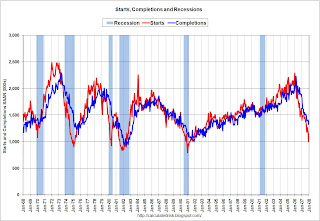このブログでも度々取上げているNY大Roubini教授は、金融災害(Financial disaster)にいたる12のステップを提唱しており、Financial Times紙のコラムで紹介されている(※1)。今の金融市場の全貌を知る良い内容だと思うので、以下に簡単に紹介したい。
ステップ1.米国市場最悪の住宅不況で、住宅価格が20~30%下落し、$4,000bn ~$6,000bn(約450~650兆円)の資産価値が失われる。 ホームエクイティがネガティブになるケースが増え、また多くの住宅建設事業者が倒産する。こうした数値はこのブログでも過去に紹介した通り。
2.サブプライムローンによる損失が、現在推定されている $250bn-$300bn(約30兆円)程度から拡大。例えばGSは$400bnと推定。住宅価格が20%以上下落すると、更に拡大。貸し渋り激化の要因。
9.ヘッジファンドの苦境に伴い、”shadow financial system"が崩壊し、SIV等中央銀行から直接借り入れの出来ない組織.の資金調達が困難となる。
Roubini教授が悲観的なシナリオを示すのはこれまでどおりだし、時折彼のシナリオが行き過ぎ(特にタイミングを予想したシナリオ)なこともあったが、これまでのところ方向性としては、概ね彼が示した方向を辿ってきている。更に彼の説をFT誌が取り上げ、十分可能性があると指摘している点は重要であろう。
Roubini教授自身は、世界大恐慌や日本のバブル後の10年に及ぶ不況ほどの事態にはならないが、米国が過去30年くらいで経験した中で最も深刻な不況になる可能性を示唆している。市場はモノラインの対策に一喜一憂している様にも見えるが、それが氷山のほんの一角に過ぎないことを、よく肝に銘じるべきだろう。
また、コラムの最後で、最終的な解決として、政府による負債の吸収かインフレ(あるいは両方)、があり、債権国の日本は前者を選んだが、債務国の米国はインフレを選ばざるを得ない懸念を示している点も要注意。

“I would tell audiences that we were facing not a bubble but a froth – lots of small, local bubbles that never grew to a scale that could threaten the health of the overall economy.” Alan Greenspan, The Age of Turbulence.
That used to be Mr Greenspan’s view of the US housing bubble. He was wrong, alas. So how bad might this downturn get? To answer this question we should ask a true bear. My favourite one is Nouriel Roubini of New York University’s Stern School of Business, founder of RGE monitor.
Recently, Professor Roubini’s scenarios have been dire enough to make the flesh creep. But his thinking deserves to be taken seriously. He first predicted a US recession in July 2006*. At that time, his view was extremely controversial. It is so no longer. Now he states that there is “a rising probability of a ‘catastrophic’ financial and economic outcome”**. The characteristics of this scenario are, he argues: “A vicious circle where a deep recession makes the financial losses more severe and where, in turn, large and growing financial losses and a financial meltdown make the recession even more severe.”
Prof Roubini is even fonder of lists than I am. Here are his 12 – yes, 12 – steps to financial disaster.
Step one is the worst housing recession in US history. House prices will, he says, fall by 20 to 30 per cent from their peak, which would wipe out between $4,000bn and $6,000bn in household wealth. Ten million households will end up with negative equity and so with a huge incentive to put the house keys in the post and depart for greener fields. Many more home-builders will be bankrupted.

Step two would be further losses, beyond the $250bn-$300bn now estimated, for subprime mortgages. About 60 per cent of all mortgage origination between 2005 and 2007 had “reckless or toxic features”, argues Prof Roubini. Goldman Sachs estimates mortgage losses at $400bn. But if home prices fell by more than 20 per cent, losses would be bigger. That would further impair the banks’ ability to offer credit.
Step three would be big losses on unsecured consumer debt: credit cards, auto loans, student loans and so forth. The “credit crunch” would then spread from mortgages to a wide range of consumer credit.
Step four would be the downgrading of the monoline insurers, which do not deserve the AAA rating on which their business depends. A further $150bn writedown of asset-backed securities would then ensue.
Step five would be the meltdown of the commercial property market, while step six would be bankruptcy of a large regional or national bank.
Step seven would be big losses on reckless leveraged buy-outs. Hundreds of billions of dollars of such loans are now stuck on the balance sheets of financial institutions.
Step eight would be a wave of corporate defaults. On average, US companies are in decent shape, but a “fat tail” of companies has low profitability and heavy debt. Such defaults would spread losses in “credit default swaps”, which insure such debt. The losses could be $250bn. Some insurers might go bankrupt.
Step nine would be a meltdown in the “shadow financial system”. Dealing with the distress of hedge funds, special investment vehicles and so forth will be made more difficult by the fact that they have no direct access to lending from central banks.
Step 10 would be a further collapse in stock prices. Failures of hedge funds, margin calls and shorting could lead to cascading falls in prices.
Step 11 would be a drying-up of liquidity in a range of financial markets, including interbank and money markets. Behind this would be a jump in concerns about solvency.
Step 12 would be “a vicious circle of losses, capital reduction, credit contraction, forced liquidation and fire sales of assets at below fundamental prices”.
These, then, are 12 steps to meltdown. In all, argues Prof Roubini: “Total losses in the financial system will add up to more than $1,000bn and the economic recession will become deeper more protracted and severe.” This, he suggests, is the “nightmare scenario” keeping Ben Bernanke and colleagues at the US Federal Reserve awake. It explains why, having failed to appreciate the dangers for so long, the Fed has lowered rates by 200 basis points this year. This is insurance against a financial meltdown.

Is this kind of scenario at least plausible? It is. Furthermore, we can be confident that it would, if it came to pass, end all stories about “decoupling”. If it lasts six quarters, as Prof Roubini warns, offsetting policy action in the rest of the world would be too little, too late.
Can the Fed head this danger off? In a subsequent piece, Prof Roubini gives eight reasons why it cannot***. (He really loves lists!) These are, in brief: US monetary easing is constrained by risks to the dollar and inflation; aggressive easing deals only with illiquidity, not insolvency; the monoline insurers will lose their credit ratings, with dire consequences; overall losses will be too large for sovereign wealth funds to deal with; public intervention is too small to stabilise housing losses; the Fed cannot address the problems of the shadow financial system; regulators cannot find a good middle way between transparency over losses and regulatory forbearance, both of which are needed; and, finally, the transactions-oriented financial system is itself in deep crisis.
The risks are indeed high and the ability of the authorities to deal with them more limited than most people hope. This is not to suggest that there are no ways out. Unfortunately, they are poisonous ones. In the last resort, governments resolve financial crises. This is an iron law. Rescues can occur via overt government assumption of bad debt, inflation, or both. Japan chose the first, much to the distaste of its ministry of finance. But Japan is a creditor country whose savers have complete confidence in the solvency of their government. The US, however, is a debtor. It must keep the trust of foreigners. Should it fail to do so, the inflationary solution becomes probable. This is quite enough to explain why gold costs $920 an ounce.
The connection between the bursting of the housing bubble and the fragility of the financial system has created huge dangers, for the US and the rest of the world. The US public sector is now coming to the rescue, led by the Fed. In the end, they will succeed. But the journey is likely to be wretchedly uncomfortable.
*A Coming Recession in the US Economy? July 17 2006, www.rgemonitor.com; **The Rising Risk of a Systemic Financial Meltdown, February 5 2008; ***Can the Fed and Policy Makers Avoid a Systemic Financial Meltdown? Most Likely Not, February 8 2008
martin.wolf@ft.com
 Click on graph for larger image.
Click on graph for larger image. The second graph shows the year-over-year change in the Case-Shiller index.
The second graph shows the year-over-year change in the Case-Shiller index.














